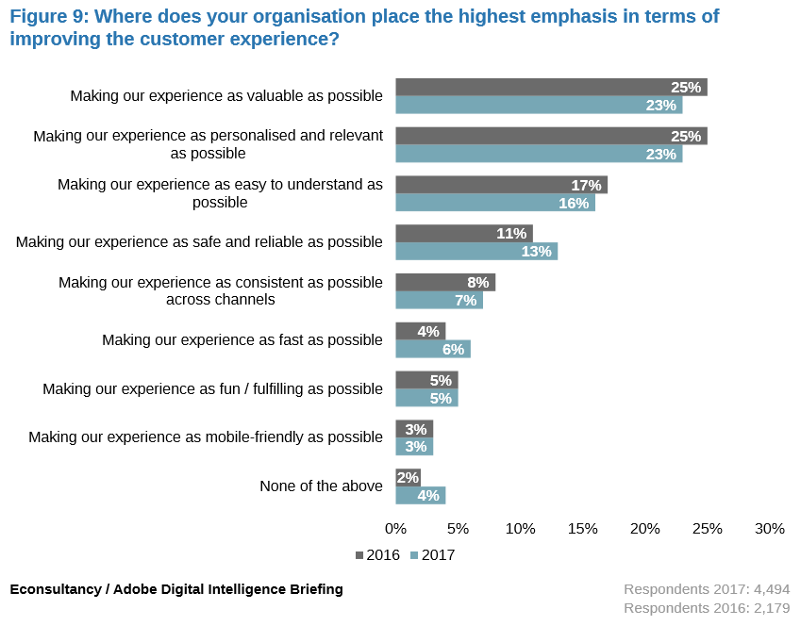Taking user experiences to the next level (with realtime)
Realtime is increasingly becoming table stakes for messaging, collaboration, or event apps. But this doesn’t mean there isn’t room for improvement – and there are all sorts of engaging ways to add realtime to apps that don’t have it yet. We’ll dive into some examples and best practices.
Realtime is important (duh)
Realtime is the new normal: businesses and consumers expect up-to-date information at their fingertips. Improving or adding realtime capabilities is becoming high priority. The 2017 Econsultancy Digital Trends report asked marketers which part of the user experience was most important to improve:
 There was a full 50% increase in the number of respondents who said that “making our experience as fast as possible” was important year over year – the most dramatic increase for any answer (besides “none of the above”).
There was a full 50% increase in the number of respondents who said that “making our experience as fast as possible” was important year over year – the most dramatic increase for any answer (besides “none of the above”).
Have a realtime app and want to improve it?
Maybe you’ve built a chat or collaboration app and already have the realtime capabilities users expect. This doesn’t mean you can’t refine what you’re already doing – and the approaches taken by Facebook’s Messenger chatbots and Slack’s many app integrations can provide guidance. On a high level, designers of both apps have anticipated common interactions that would occur in realtime, in-stream – like a chatbot for a hotel offering a room reservation or a salesperson in a Slack channel linking to a prospect record in Salesforce.
Both Slack and Facebook have built powerful capabilities to bring the response to these interactions into their apps in realtime, instead of requiring a link out to a booking site or Salesforce.com. The more seamless the experience, the more likely users are to stay in their (or your app). If you already have reatime capabilities, think about common use cases for your app and how you can pull more data or actions into those user flows to enable realtime reaction.
Adding realtime to your app
There’s substantial value in pulling realtime data into your user experience – even if it’s not strictly necessary. Phil Leggetter wrote a great blog post on how to discover and handle the realtime data in your app that’s a great first step for kicking off the process. Realtime data was added to Google Analytics last year, providing the ability to immediately see the impact of real-world events or marketing campaigns. Maybe you already have realtime counters or logs – then bringing them into a UI requires a useful visualization. We see supplementary realtime data as particuarly interesting in eCommerce or retail, where social proof or inventory data displayed at the right moment to a potential customer can improve conversion. In a similar fashion, Uber’s ‘cars in your area’ UI (hint – there may not be that many drivers actually near you) is a great example of how “realtime” data can fundamentally change a user’s perception of your product or service. We’re confident that if you spend some time brainstorming, you can arrive at a novel way to incorporate realtime as well.
Recent posts
-
We've been acquired by Fastly
-
A cloud-native platform for push APIs
-
Vercel and WebSockets
-
Rewriting Pushpin's connection manager in Rust
-
Let's Encrypt for custom domains
 • filed under
• filed under